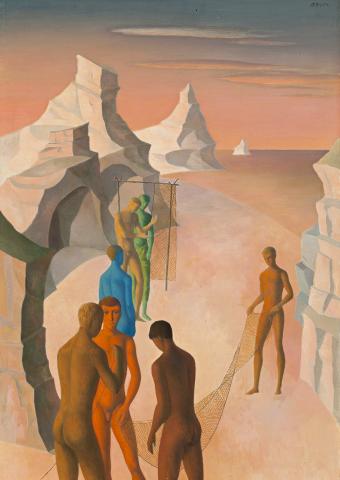THE NET MENDERS, 1965
JUSTIN O'BRIEN
oil on canvas
70.0 x 49.5 cm
signed upper right: O’BRIEN
bears inscription verso: NATIONAL GALLERY MELBOURNE
Bradshaw Collection, Sydney
Sotheby’s, Melbourne, 4 May 2004, lot 69
Gould collection, Melbourne
Justin O’Brien, Macquarie Galleries, Sydney, 1965
Justin O’Brien Retrospective, National Gallery of Victoria, Melbourne, 1987
The Director’s Choice 2015, Celebrating 35 Years, Gould Galleries, Melbourne, 1 May – 13 June 2015, cat. 14 (illus. in exhibition catalogue)
France, C., Justin O’Brien: Image and Icon, Craftsman House, Sydney, 1997, pp. 26, 110 (illus.), 142
Fixed in striking classical poses, the lithe, idealised fishermen who inhabit Justin O’Brien’s painting were inspired by the artist’s quotidian experience in Greece. Yet they remain linked to the apostolic fishermen, the harbingers of spiritual completeness who populate many of O’Brien’s works. Painting spiritual subject matter provided the Australian artist with the possibility of uninhibited artistic expression, unconfined by the physical limitations of visual perception, a freedom that he would later extend to his more prosaic scenes.
The figure of a fisherman first appears in O’Brien’s watercolours of the 1940s, such as Mending the Nets, c.1947, then later within the larger framework of polyptychs of the 1950s including Miraculous Draught of Fishes, then again in works from the 1960s after the artist’s return to his house on the island of Skyros in the Aegean. While The Net Menders, 1965 is a prosaic scene, it is one whose origins are steeped in ancient Christian iconography. These men are set firmly within the stylised and anonymous topography that came to represent O’Brien’s work – rocky outcrops, dusty ground and golden hued skies. The Net Menders is a good example of O’Brien’s distinctive pictorial style, which included a refusal of linear perspective, non-representational primary colour, and a geometric flattening of the pictorial plane. It has been suggested that these devices were strongly influenced by the artist’s discovery of Renaissance art in Europe, particularly the modern day appearance of frescoes from the Quattrocento.1
The Greek island of Skyros was a recurring source of aesthetic attraction for the artist – he lived on the island throughout the summers of 1964, 1967 and 1971, exhibiting the dozens of paintings the location inspired at Sydney’s Macquarie Galleries in the year following each trip. The island was also source of a stylistic shift in the artist’s work, leading to a stronger definition of line and more subtle naturalistic colour, as well as a greater proportion of landscapes and still lives.2 With a mysterious serenity and sparseness that would characterise many of O’Brien’s paintings, The Net Menders has an eerie power reminiscent of Surrealism. For O’Brien, who had suffered through multiple crises of faith, there was certain symmetry in his search for the spiritual in prosaic scenes and the intensity of his narrative paintings. He explained this to the art critic Sasha Grishin in 1982: ‘the religious experience should not be confused with the spiritual experience, for the latter can be expressed through many subjects, like a vase of flowers’.3
The languorous figures of Net Menders, 1965, are simply presented as performing an age-old artisanal activity that would have supported their livelihood on the island, as they were in the artist’s watercolour sketch of the 1940s. Mending their nets in early evening light, the naked fishermen are avatars of a timeless era, untied to geographical or temporal specificity.
1. France, C., Justin O’Brien. Image and Icon, Craftsman House, Sydney, 1997, pp. 15 – 17
2. Wilson, N., ‘Justin O’Brien & The Art of Transfiguration’, Justin O’Brien, The Sacred Music of Colour, exhibition catalogue, Art Gallery of New South Wales, Sydney, 2010, pp. 110 – 111
3. O’Brien to Sasha Grishin, 18 January 1982, quoted in Grishin, S., ‘Justin O’Brien, in retrospect’, Justin O’Brien: A Survey Exhibition 1938 – 95, Philip Bacon Galleries, Brisbane, 2006, p. 15
LUCIE REEVES-SMITH
